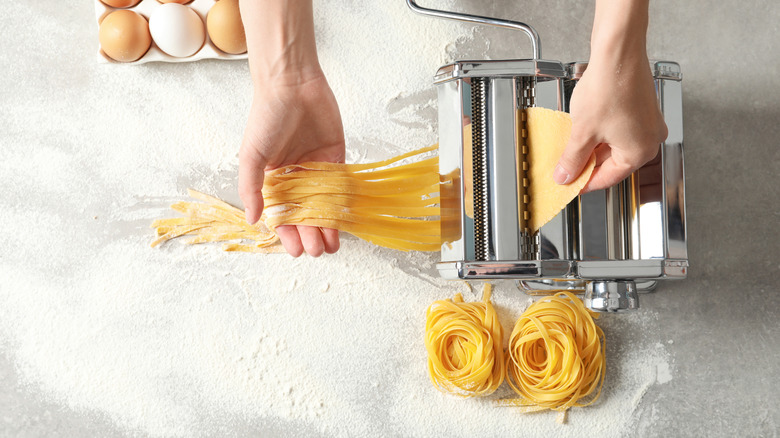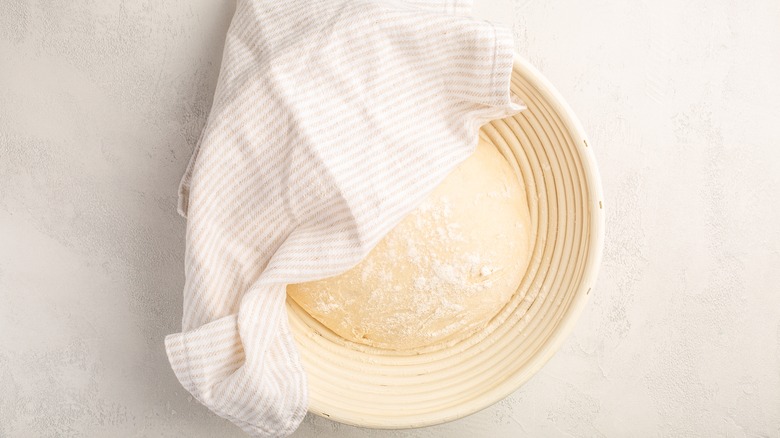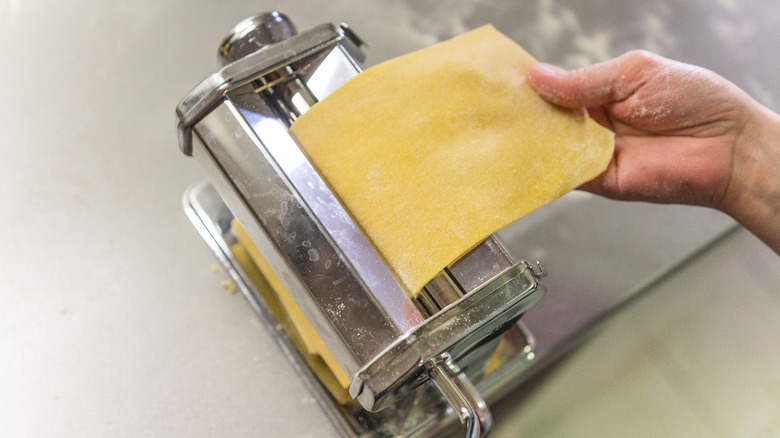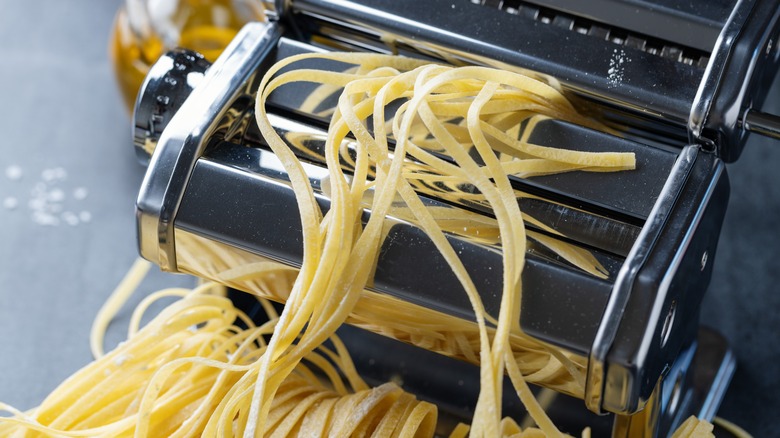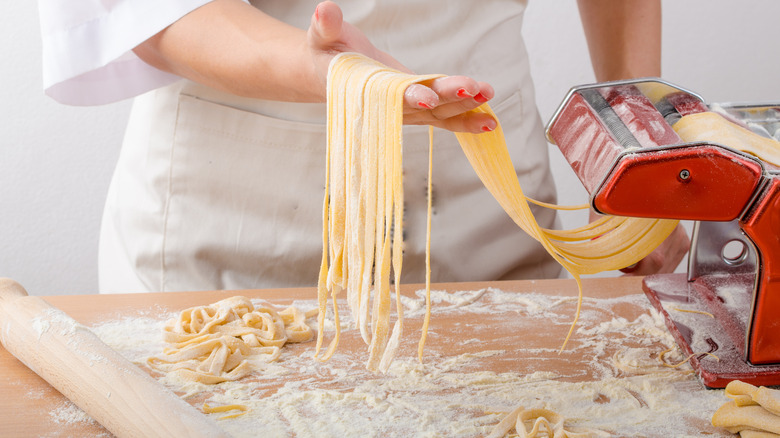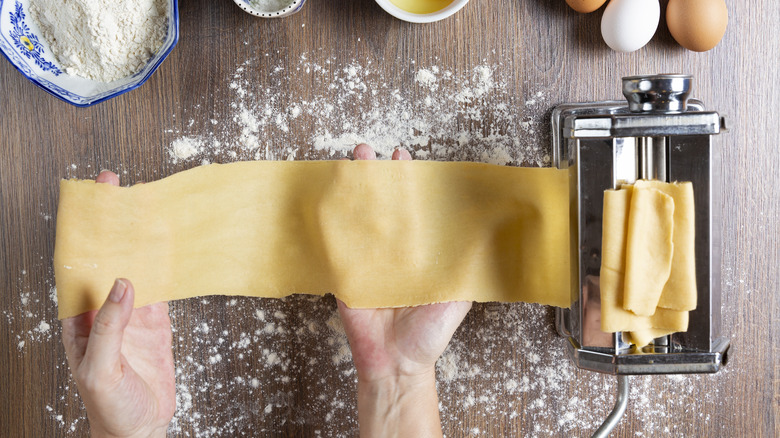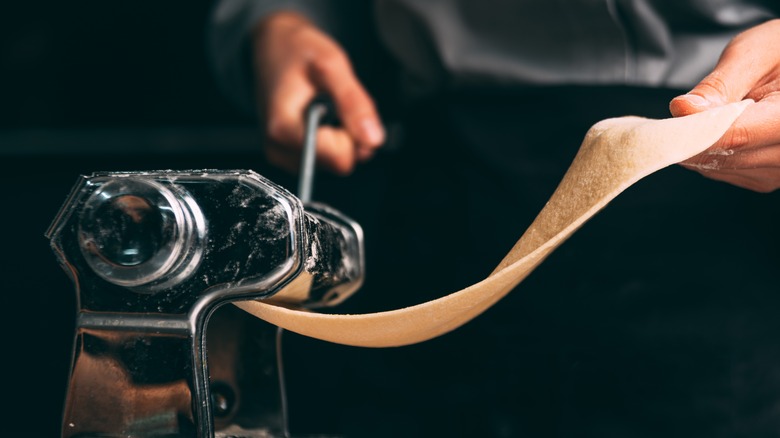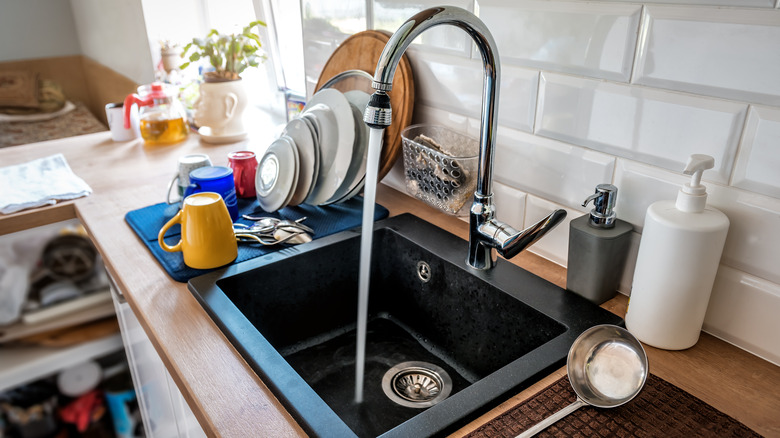11 Mistakes Everyone Makes Using A Pasta Machine
When I married an Italian and moved to Italy four years ago, there was one thing I knew I was going to have to learn: how to make pasta. Luckily, my husband's mom and aunt are experts on this topic and were willing to teach me everything they know, including how to use a pasta machine.
Back in the States, I had never used a pasta machine before, and I'm not going to lie, I may have gone into it with a bit more confidence than I should have. It seems so simple: You just put the dough in one side of the machine, turn the crank, and out comes the pasta, right? If only it were that easy.
There are a lot of mistakes to be made when making homemade pasta with a pasta machine, and I have made most of them. Learn from my mishaps so your pasta turns out perfect every time.
1. Mistake: Using dough that is too wet
One of the toughest parts of making pasta is getting the consistency of the dough just right. Too dry and it is unworkable, but too wet and it is just a sticky mess. The latter is especially problematic when it comes to using a pasta machine. If your dough is too wet, it will stick to the table, the towel, your fingers... but more importantly it will stick to the machine.
If you try to push moist dough through the pasta maker, it will gum up the works very quickly. The dough will get stuck to the rollers or the attachments/extruder, and can even get stuck inside the interior of the pasta machine –- which is very hard to clean.
To avoid this problem, you have to start with the dough itself. Perfect pasta dough should be firm to the touch and should not stick to your fingers if you tap it. It should not be crumbly or hard, but it should hold its own shape and be flexible when you work with it.
The biggest tip, though, is to add flour as you work. Before you put the dough on your work surface, dust it with flour. If your dough seems a bit sticky once you start working with it, add some flour. Rolling out your dough to make it flatter? Add some flour. Flour is your best friend when working with dough, so make sure to always have some handy.
2. Mistake: Letting your dough dry out while you work
Just as wet dough makes it hard to use a pasta machine, dry dough can cause problems too. This is a very common mistake because it is an easy one to make. You might start off with dough that is exactly the right texture with exactly the right level of moisture, but making pasta takes time. During the process, you will take a hunk of dough, put that through the machine, then fold the dough over and repeat several times. This leaves the other dough, the piece you are not using, exposed to the air in your kitchen.
Pasta dough very quickly becomes dry when it is left out in the air too long. You may not even fully notice that it's happening until the pasta you are making begins to tear when you put it through the machine or it comes out with hard spots that seemingly weren't there before.
So, what's a pasta maker to do? Fortunately there is an easy fix for this. Cover the dough you are not using with a towel or some plastic wrap. You can put it in a bowl or leave it on the work surface, but the main thing is to cover it completely so that the air can't dry it out before you're ready to use it.
3. Mistake: Using the thinnest setting first
We all get impatient in the kitchen sometimes. We want that delicious homemade pasta, and we want it as fast as possible! Unfortunately, rushing can lead to another common pasta making mistake: using the thinnest setting right off the bat.
Yes, you want your pasta thin, but you have to thin it out gradually. Putting your unpressed dough into the machine and setting it to the lowest setting right away will result in pasta pieces that come out oddly shaped, torn, and an odd, wrinkly texture. It may seem like a way to save time, but in the end it wastes it because you have to spend even more time trying to get the dough out of the machine when it gets stuck.
Instead, you need to reduce the thickness little by little, lowering your setting by just one or two numbers at a time. Put the dough through with the thicker setting, fold it over, then run it through again. When it's thinner and smooth, you can change to a lower setting and run it through again, proceeding this way until you reach your desired thickness (or, more precisely, thinness).
4. Mistake: Not realizing there is dough stuck in the machine
Pasta machines, especially the kind with the hand-crank, may seem pretty simple at first glance. You would never guess that they are actually full of tiny nooks and crannies where dough can get stuck and ruin the pasta you are trying to make.
This problem is usually first noticed when you see that your flat strips of pasta are coming out with holes or long, scratch-like marks. It will resemble a piece of fabric that got ripped somehow, even though you can't see anything sharp on the machine that could tear it. The culprit here is almost always a small piece of dough that is stuck in the inner mechanism or between the rollers. Even just a tiny crumb can cause big problems that will have you wanting to tear your hair out as you pull your ruined pasta from the machine.
But, this is a problem that can easily be solved. If you notice these rips or holes in your pasta, stop, take the dough out, and take a look at the interior of the machine. Do you see something between the rollers? Do you see anything squished against the sides? If so, remove the stuck pieces with a toothpick or a dry, clean toothbrush. Do not wash the machine in the sink! (More on that in another section.) Once the stuck piece is free, your pasta should come out just fine.
5. Mistake: Not using the proper technique
Pasta machines can make rolling out pasta a lot easier. You don't have to use a rolling pin and you don't have to eyeball the measurement of the dough's thickness because the machine gets it to the perfect size. You do, however, need to use the proper technique to fold your dough to get good results.
First, take your dough and cut it into four pieces. Flatten one of those pieces with your hand (no rolling pin needed), then feed the dough into the machine at the largest setting, starting with a smaller side or a corner. Turn the crank (if you don't have an electric pasta maker) and take hold of the thinner, smoothed-out dough as it comes out the other side.
This is where the trick comes in. Your dough is not yet pasta at this point. You have to take the strip that came out of the machine and gently fold it over into another rectangle. Depending on how big it is, you can either fold it in half or fold it into three pieces like you would fold a letter to stick in an envelope. Then, run it through the machine again, and repeat this process several more times until your dough is nice and smooth. After this, you can move to a thinner setting or eventually move to one of the attachments to make a specific type of pasta, like fettuccine or tagliatelle.
6. Mistake: Trying to use too much dough at once
Another mistake made by the impatient chefs is to try to use too much dough at once. It might seem like the pasta making process will go faster if you put a bigger piece of dough into the machine, but in reality, this just leads to a clogged machine. Signs that you are using too much dough include: dough oozing out the sides instead of going through the rollers; a piece of pasta that is distorted or isn't straight; pasta that is too long to manage easily; pasta that is too wide to pass through the machine a second time; and a crank that won't turn because the machine is jammed.
The key here is to break down your original ball of dough into smaller, more manageable pieces. Cut it into at least four chunks, then flatten them and see if they look like they are too wide to fit through the machine. If not, try to put one through. If it works, then this is a good amount to start with. If it gets stuck, consider cutting it down to a smaller piece and using that as your go-to measurement. Unfortunately, there is not really a set recommendation for size here, it is something you have to learn through trial and error based on your machine.
7. Mistake: Not letting your dough rest first
This mistake might seem more tied to dough-making itself than the pasta machine, but rest assured (no pun intended) that resting the dough is a very important step in using a pasta machine. Pasta making, like most things in cooking, is a science. It involves a series of chemical reactions in order to turn a set of ingredients into one cohesive food.
In this case, the dough needs to rest in order to allow the gluten it creates to trap carbon dioxide particles. This is what makes the dough springy, sturdy, and soft. If you don't give your dough around 30 minutes to rest, it may not be as workable because this chemical process hasn't taken place.
So, in other words, your work with the pasta machine should start long before you get take it off your shelf. Factor in around half an hour for the dough to rest at room temperature if you want it to be the right consistency for making perfect pasta.
8. Mistake: Letting your pasta noodles get too long
This mistake is one that might seem obvious... until you start using the pasta machine. Sometimes, when you put the dough into the machine, the pasta that comes out just seems to stretch on forever. You may think at this point, "So what? I can just cut it when I'm done!" but unless you're a highly experienced pasta maker, that might not be the best idea.
Using a piece of dough that's too big can lead to a strip of pasta that is too long to handle, especially if you are working alone. If your pasta is too long, it might fold up on itself, which could lead to it sticking together, which could lead to you having to run it through the machine a few more times to iron it out. It may also lead to the pasta breaking under its weight and falling on the floor, and those you are serving your pasta to won't like seeing bits of dirt and cat hair in it.
Usually, pasta is cut to size after it has all been run through the machine, but you can save some time and make things a bit easier on yourself by making multiple batches of already-shorter pasta instead of a mile-long piece. Always keep in mind that if it's getting too long, you can stop and cut your pasta before proceeding with the rest of the dough to maintain better control.
9. Mistake: Not asking for help
Many home chefs like to do everything on their own, and that's just fine most of the time. However, when it comes to using the pasta machine, it may be a good idea to have a partner or an assistant. Especially when using a hand-crank pasta maker, it can be tricky to both put the dough in and catch the pasta when it comes out as you turn the crank. If only we had three hands instead of two!
Typically, a good pasta-making team consists of a "cranker" and a "catcher," meaning one person turns the handle and puts the dough in while the other person gently catches and guides the dough out so that it doesn't fold up on itself or hang down onto the table or floor. In addition to this being a more efficient way to work, it is also a nice way to spend time with your family or friends — and a clever way to make them work for their dinner.
10. Mistake: Turning the crank too fast
Turning the crank too fast is yet another mistake that is almost always attributed to impatience. However, we won't lie: There really is something very fun about turning the crank on the pasta maker. You might be tempted to turn it fast, not just to get the job done more quickly, but also just because it feels good to do. However, this is a recipe for disaster.
If you turn the handle too fast, the dough doesn't go in smoothly and comes out choppy, inconsistent, and the wrong texture. It may tear and come out in ripped chunks, which is not at all what you want. What you do want is to turn the handle slowly and steadily. This will ensure that the dough goes through a bit at a time, not all at once, and it will lead to smoother, better piece of pasta. It may be difficult at first to find the right speed, but with a bit of practice, you will find the right rhythm.
11. Mistake: Washing the pasta machine in the sink or dishwasher
When one of your kitchen tools is dirty, your first instinct is to wash it in the sink or dishwasher, right? Some hot water and soap are all you need, right? Wrong! When it comes to your pasta machine, you should keep that thing as far away from water as possible. Regardless of whether it is an electric pasta machine or the hand-crank kind, submerging the machine in water is always a bad idea. These machines have a lot of small parts and a lot of small crevices where water can get stuck, which can lead to a build up of rust or bacteria, neither of which you want in your pasta.
Instead, use a clean, dry toothbrush or a can of compressed air to get out any dough that may have gotten stuck while you were working. To get things clean, run a piece of leftover, unusable dough or some clay through the machine to catch any crumbs or residue that were left behind between the rollers. If necessary, you may have to take the machine apart to clean the inside, but even then you should avoid using water to clean it.
